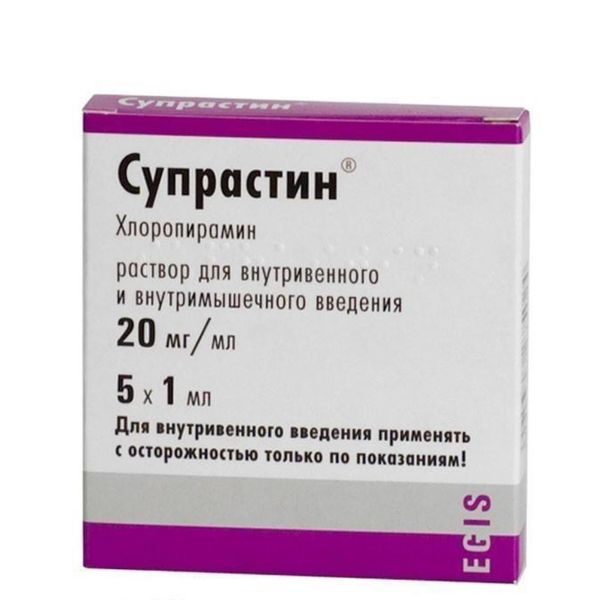|
Quantity
|
Out of stock
|
||
|
|
|||
Storage:
active substance: chloropyramine;
1 ml contains 20 mg of chloropyramine hydrochloride;
excipients: water for injections.
Medicinal form. Solution for injection.
Pharmacotherapeutic group.
Antihistamines for systemic use.
PBX code R06A C03.
Clinical characteristics.
Indication.
Allergic diseases - seasonal allergic rhinitis; conjunctivitis; urticaria; contact dermatitis; food allergy; allergic reactions caused by medicines; allergy caused by insect bites.
As adjunctive therapy for systemic anaphylactic reactions and angioedema.
Contraindication.
Hypersensitivity to any ingredient included in the preparation; acute attacks of asthma; acute myocardial infarction, arrhythmias; benign hyperplasia of the prostate gland; closed-angle glaucoma; urinary retention; simultaneous use of MAO inhibitors.
Method of application and dosage.
Suprastin® injection solution can only be administered by a doctor or a nurse. Injections are administered intramuscularly. In case of anaphylactic shock or acute, severe allergic reactions, it is recommended to start the treatment with intravenous administration of Suprastin®, and then switch to intramuscular injections or oral administration of tablets. The duration of treatment is determined by the doctor.
Adults
The daily dose for adults is usually 1-2 ml.
Children.
Recommended starting dose:
- children aged 1-12 months: 1/4 ampoule (0.25 ml);
- children aged 1-6 years: 1/2 ampoule (0.5 ml);
- children aged 6-14 years: 1/2-1 ampoule (0.5 ml - 1 ml).
In this case, it is necessary to use an insulin syringe with a needle for intramuscular administration.
The daily dose for a child should not exceed 2 mg/kg of body weight.
Violation of liver function.
It may be necessary to reduce the dose, since the metabolism of the active substance decreases with liver disease.
Impaired kidney function.
In case of impaired kidney function, it is necessary to reduce the dose of the drug, since the active substance is excreted mainly by the kidneys.
Adverse reactions.
From the side of the central nervous system: sedative effect, increased fatigue, dizziness, ataxia, nervousness, tremors, convulsions, headache, euphoria, encephalopathy, blurred vision, drowsiness, deterioration of psychomotor functions.
From the side of the cardiovascular system: arterial hypotension, tachycardia, arrhythmia.
From the side of the digestive tract: pain and discomfort in the epigastric region of the stomach, dry mouth, nausea, vomiting, diarrhea, constipation, anorexia, increased and decreased appetite, worsening symptoms of gastroesophageal reflux.
From the side of the blood system: leukopenia, agranulocytosis, thrombocytopenia, hemolytic anemia, other pathological changes in the blood.
On the part of the organs of vision: increased intraocular pressure, glaucoma.
From the kidneys and urinary system: dysuria, urinary retention.
From the side of the skin and subcutaneous tissue: photosensitivity, allergic reactions.
From the musculoskeletal system and connective tissue: myopathy.
From the side of the immune system: allergic reactions, including skin hyperemia, rash, itching, urticaria, angioedema.
Others: changes in the injection site.
Overdose.
Deliberate or accidental overdose of antihistamines can be fatal, especially in children. With an overdose of Suprastin®, symptoms similar to atropine intoxication develop: hallucinations, restlessness, ataxia, impaired coordination of movements, athetosis, convulsions. In children, the state of excitement dominates. Dry mouth, dilated pupils, flushing, sinus tachycardia, urinary retention, and dyspnea may also occur. In adults, heartburn and hot flashes are not always observed; the period of excitement is accompanied by convulsions and postictal depression. In addition, coma and cardiopulmonary collapse can occur, which can lead to death within 2 - 18 hours.
Cardiopulmonary function monitoring is recommended. Treatment is symptomatic. The antidote is unknown.
Use during pregnancy or breastfeeding.
Due to the lack of data from adequate well-controlled studies, the use of SuprastinÒ during pregnancy or breastfeeding is contraindicated.
Children. SuprastinÒ can be used in children over 1 month old. Contraindicated for use by newborns and premature children.
Features of application.
Elderly patients, exhausted patients.
With special caution, prescribe SuprastinÒ to these groups of patients, as they are more sensitive to certain side effects of antihistamines (dizziness, drowsiness, lowering of blood pressure).
Due to the anticholinergic and sedative effects of the drug, special caution should be observed when using the drug in elderly patients, patients with impaired liver function or with cardiovascular disorders.
If the drug is used late at night, the symptoms of gastroesophageal reflux may increase.
When using SuprastinÒ in combination with ototoxic agents, warning symptoms of ototoxicity may be masked.
Alcohol can increase the sedative effect of antihistamines
the central nervous system.
Long-term use of antihistamines can rarely cause disorders of the hematopoietic system (leukopenia, agranulocytosis, thrombocytopenia, hemolytic anemia). If undesirable effects occur during long-term use of the drug (sore throat, laryngitis, formation of ulcers on the mucous membrane of the oral cavity, pallor, jaundice, hematomas, bleeding), it is necessary to stop the treatment and monitor blood parameters.
The ability to influence the speed of reaction when driving a motor vehicle or working with other mechanisms.
During the use of the drug, especially in the first period of treatment, the drug can cause drowsiness and deterioration of psychomotor functions (see the section "Peculiarities of use"). Thus, taking into account possible adverse reactions from the nervous system, driving a motor vehicle or working with other mechanisms should be prohibited at the beginning of therapy during the period established in each specific case on an individual basis. Later, the degree of restriction or prohibition must be determined individually.
Interaction with other medicinal products and other types of interactions.
MAO inhibitors increase and prolong the anticholinergic effect of the drug. Special care should be taken when prescribing the drug simultaneously with sedatives, barbiturates, hypnotics, tranquilizers, opioid analgesics, tricyclic antidepressants, atropine, muscarinic parasympatholytics due to the possibility of mutual potentiation of each other's effects.
Alcohol increases the depressant effects of Suprastin® on the central nervous system, therefore, during treatment with the drug, drinking alcoholic beverages should be avoided.
In combination with ototoxic drugs, warning signs of ototoxicity may be masked.
Antihistamines can prevent a skin reaction in allergy testing, so the use of such drugs should be stopped a few days before the scheduled allergy skin test.
Pharmacological properties.
Pharmacodynamics.
Chloropyramine, a chlorinated analogue of tripellenamine (pyribenzamin) is a first-generation antihistamine that belongs to the group of ethylenediamines.
The mechanism of action of the drug consists in blocking histamine H1 receptors. The drug also affects smooth muscles, permeability of capillaries and the central nervous system.
The drug relieves the general symptoms of allergic diseases, in addition to anti-allergic, it has sedative, soporific and antipruritic effects.
Pharmacokinetics.
Chloropyramine is metabolized in the liver. It is excreted mainly with urine in the form of metabolites. In children, the drug can be eliminated faster than in adult patients. In case of impaired kidney function, the excretion of the active substance may decrease.
In case of liver failure, the metabolism of chloropyramine slows down, which requires correction of the dose of the drug.
Pharmaceutical characteristics.
Main physico-chemical properties: colorless transparent aqueous solution with a weak characteristic smell.
Expiration date.
5 years.
Storage conditions.
Store at a temperature not higher than 25 oC in a place inaccessible to children.

































